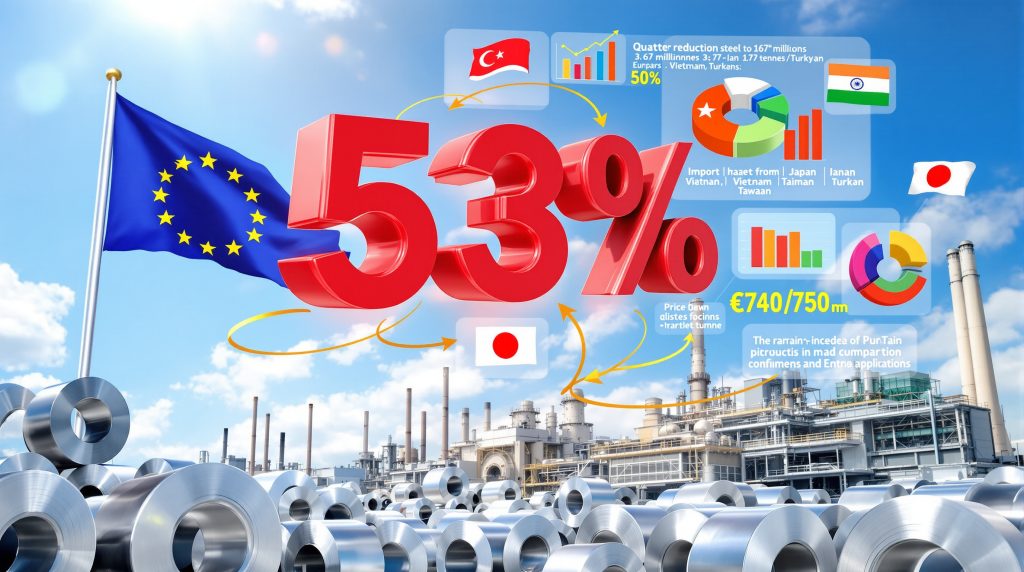Understanding European Cold-Rolled Coil Supply Dynamics
The European cold-rolled coil market faces an unprecedented convergence of supply disruptions and regulatory changes that fundamentally reshape industry dynamics. Furthermore, EU cold-rolled coil market supply issues have created a complex landscape where traditional supply chains require strategic reassessment due to production facility interruptions combined with evolving trade policies.
Recent industrial incidents have eliminated substantial production capacity from key European facilities. Manufacturing disruptions at major Italian production sites have removed approximately 2.5 million tonnes of annual capacity from the market, creating immediate availability constraints across the continent.
These capacity reductions coincide with significant modifications to European Union import regulations. New quota restrictions reduce duty-free import allowances from 3.67 million tonnes to 1.73 million tonnes annually, representing a 53% decrease in accessible foreign supply starting April 2025.
Production Facility Disruptions Reshape Market Availability
Industrial fire incidents at major European cold-rolled coil facilities have created immediate supply constraints affecting multiple market segments. The October 2025 fire at Marcegaglia's Ravenna production facility represents the most significant recent disruption to European CRC manufacturing capacity.
This incident affected one of three mills operated by Italy's primary CRC supplier, though specific details regarding the affected production line remain undisclosed. The facility operates with a combined annual capacity of 2.5 million tonnes across its three manufacturing lines, making any extended downtime particularly impactful for regional supply chains.
Market participants express concerns regarding restart timelines, with industry sources suggesting potential extended closure periods. The affected company has declined to provide specific restoration schedules, leaving buyers uncertain about future supply availability.
Key Production Impact Metrics:
- Total affected capacity: Approximately 2.5 million tonnes annually
- Fire occurrence: October 25-26, 2025
- Facility status: Uncertain restart timeline
- Market position: Primary Italian CRC supplier post-consolidation
Regional buyers have indicated necessary supply chain reorientation following this production disruption. Spanish and Italian purchasers report shifting procurement strategies away from import dependencies toward domestic European producers, assuming increased merchant market allocation.
Supply Chain Concentration Risks
The Italian market demonstrates particular vulnerability to single-source dependencies. Following industry consolidation trends, Marcegaglia emerged as the dominant domestic CRC supplier, creating concentration risks that become apparent during production disruptions.
This market structure forces buyers to maintain relationships with multiple suppliers across different regions to ensure supply security. The current situation highlights the importance of diversified sourcing strategies in managing industrial risk exposure.
Trade Policy Transformations Affecting Import Flows
European Union trade policies undergo significant modifications that directly impact cold-rolled coil import accessibility and pricing structures. These regulatory changes target specific supplier countries whilst restructuring quota allocation mechanisms.
Anti-dumping investigations focus on five primary source countries: India, Japan, Vietnam, Taiwan, and Turkey. These nations collectively represent 67% of total EU CRC imports in 2024, with their share reaching 63% during the January-August period.
The investigation process could substantially reduce import flows if dumping determinations are reached. Market participants anticipate significant supply reallocation as traditional sourcing channels face potential restrictions, particularly considering US–China trade war effects that continue to reshape global trade dynamics.
Import Quota Restructuring:
| Previous Quota | New Quota | Reduction | Implementation |
|---|---|---|---|
| 3.67 million tonnes | 1.73 million tonnes | 53% | April 2025 |
Safeguard mechanism modifications create additional supply constraints through reduced duty-free import thresholds. The new framework establishes 50% tariff rates on above-quota volumes, potentially increasing import costs for buyers requiring additional tonnage.
Anti-Dumping Investigation Scope
The ongoing anti-dumping investigation targets countries that collectively supply nearly two-thirds of EU cold-rolled coil imports. This broad scope suggests substantial market restructuring if protective measures are implemented.
Market expectations centre on April 2025 implementation, though specific duty rates and definitive conclusions remain pending. Buyers express concerns about supply availability during the investigation period, with some accelerating procurement to secure inventory before potential restrictions take effect.
Market Segment Supply Constraint Analysis
Different cold-rolled coil market segments experience varying degrees of supply pressure, with merchant markets facing particularly acute availability constraints. Pre-existing capacity allocations had already created tight conditions before recent production disruptions.
Fourth-quarter 2024 merchant market capacity was completely allocated prior to industrial incidents, forcing buyers to seek alternative sources or accept premium pricing for limited availability tonnages. This situation reflects underlying supply-demand imbalances that production disruptions have exacerbated.
Premium pricing emerges for smaller volume purchases, with buyers paying €740-750 per tonne base delivered for limited tonnage availability. These price levels exceed hot-dip galvanised product costs, representing an unusual market inversion.
Market Segment Impact Assessment:
- Merchant market: Complete Q4 2024 allocation before disruptions
- Premium pricing: €740-750/tonne for smaller tonnages
- Price inversion: CRC exceeding HDG costs
- Supply reorientation: Import-dependent buyers seeking domestic sources
Industrial Application Constraints
Automotive and construction sectors face extended lead times and increased price volatility as supply constraints affect material availability. Manufacturing supply chains require adaptation to secure adequate CRC volumes for production requirements.
Industrial buyers report necessary procurement strategy modifications to maintain production schedules. Long-term supply agreements become increasingly valuable as spot market availability diminishes and prices fluctuate.
The automotive sector, traditionally reliant on consistent CRC specifications and delivery schedules, must now navigate longer lead times and potential specification compromises. Construction applications similarly face material availability challenges that could affect project timelines.
Regional Market Variations and Supply Distribution
Geographic factors create distinct supply-demand dynamics across European markets, with certain regions experiencing more severe constraints than others. Italian market concentration creates particular vulnerability, whilst UK market conditions diverge significantly from continental patterns.
Italian Market Dependencies
Italy's cold-rolled coil market demonstrates high concentration following industry consolidation. Marcegaglia's position as the primary domestic supplier creates supply vulnerabilities when production disruptions occur.
The company's three-mill configuration provides some redundancy, but extended downtime at any facility affects overall market availability. Italian buyers express particular concern about supply security given limited domestic alternatives.
Regional supply chain relationships require strengthening to manage concentration risks effectively. Buyers explore cross-border sourcing options whilst domestic capacity remains constrained.
UK Market Divergence
The United Kingdom presents contrasting market conditions following Tata Steel's Continuous Annealing Processing Line cessation in March 2024. This facility shutdown eliminated merchant market CRC production, forcing complete import dependence.
Safeguard removal following the facility closure creates different competitive dynamics compared to continental European markets. South Korean CRC offers around £500 per tonne fall below hot-rolled coil import prices, representing unusual market positioning.
The UK market's characterisation as a destination for excess supply reflects the absence of domestic production protection. This situation creates pricing anomalies not observed in other European markets with active safeguard mechanisms.
Chinese Export Strategy Adaptation
Chinese steel producers modify export strategies to navigate European trade barriers whilst maintaining market presence through competitive positioning. Export offers incorporate duty costs whilst remaining commercially attractive to European buyers.
Chinese CRC export pricing ranges €610-620 per tonne CFR, including anti-dumping duties where applicable. This pricing strategy positions Chinese material competitively despite additional duty burdens.
Chinese Export Dynamics:
- Pricing strategy: €610-620/tonne CFR including duties
- Market penetration: Major mills securing European buyers
- Duty accommodation: Pricing incorporates penalty costs
- Competitive positioning: Above HDG pricing levels
At least one German buyer completed CRC booking from a major Chinese mill during October 2025, demonstrating continued market access despite trade policy uncertainties. Chinese exporters offer CRC above hot-dip galvanised pricing levels, reflecting global market dynamics and the tariff impact on markets.
Trade Barrier Navigation Methods
Chinese producers employ various strategies to maintain European market presence despite evolving trade restrictions. Pricing approaches incorporate expected duty costs whilst maintaining commercial viability.
Volume optimisation becomes critical as quota restrictions approach implementation. Strategic timing allows maximisation of duty-free access before April 2025 policy changes take effect.
Market positioning ahead of regulatory changes enables Chinese exporters to maintain buyer relationships whilst adapting to new competitive frameworks. Long-term market access requires continuous strategy adjustment as trade policies evolve.
Production Strategy Adjustments by European Steelmakers
European steel producers implement operational modifications to address supply constraints whilst navigating challenging market conditions. Capacity reallocation strategies prioritise merchant market availability to meet increased demand from previously import-dependent buyers.
Domestic producers reassess grade optimisation strategies, focusing on high-demand specifications that command premium pricing. Output expansion consideration reverses previous production reduction decisions as market dynamics shift.
Strategic Production Adjustments:
- Merchant market focus: Increased CRC allocation for open market sales
- Grade optimisation: Prioritising high-demand specifications
- Output reassessment: Evaluating expansion opportunities
- Investment evaluation: Considering capacity enhancement projects
Supply chain restructuring emphasises domestic sourcing relationships as buyers seek alternatives to import dependencies. European producers benefit from increased demand whilst managing capacity constraints, particularly in light of mining evolution insights that highlight industry transformation trends.
Capacity Utilisation Enhancement
European steelmakers evaluate capacity utilisation improvements to meet increased domestic demand. Previous production reductions due to competitive pressure from lower-cost regions require reassessment given current market conditions.
Investment considerations include potential facility upgrades and capacity expansion projects. Long-term market protection through trade policies creates more favourable conditions for domestic production investment.
Operational efficiency improvements become critical for maintaining competitiveness whilst meeting increased demand. European producers must balance cost management with supply reliability requirements.
Price Formation and Market Dynamics
Cold-rolled coil pricing mechanisms undergo significant transformation as supply constraints interact with demand patterns and international trade flows. Domestic pricing premiums reflect limited availability whilst international offers remain competitive despite trade barriers.
Premium pricing emergence for smaller tonnage purchases demonstrates supply-demand imbalances in merchant markets. Buyers accepting €740-750 per tonne pricing reflect limited alternative sources and urgent supply requirements.
Comparative Pricing Analysis:
| Market | Price Range | Product Type | Special Conditions |
|---|---|---|---|
| Domestic EU | €740-750/tonne | CRC delivered | Smaller tonnages |
| Chinese exports | €610-620/tonne | CRC CFR | Including dumping duties |
| UK market | £500/tonne | CRC | Below HRC pricing |
Price inversions between CRC and hot-dip galvanised products represent unusual market conditions reflecting EU cold-rolled coil market supply issues rather than traditional value-add relationships. These dynamics extend beyond European markets, with Chinese exporters similarly pricing CRC above HDG levels.
International Price Comparison Framework
European CRC pricing demonstrates unique characteristics compared to global benchmarks, with domestic premiums reflecting supply constraints whilst international offers remain competitive despite trade barriers.
Currency effects influence competitive positioning as exchange rate fluctuations affect import cost calculations. Sterling weakness against the dollar impacts UK import pricing, creating regional pricing disparities.
Market psychology shifts as buyers adjust procurement strategies to secure supply availability rather than optimise pure cost considerations. Long-term contract premiums reflect supply security value in constrained markets, similar to patterns observed in iron ore market trends.
Future Market Outlook and Projections
Market projections indicate continued supply tightening through 2025 as quota implementations and production disruptions create lasting structural changes. Recovery timelines remain uncertain given unknown facility restart schedules and evolving trade policy frameworks.
Short-term supply constraints likely persist through quota implementation periods, with market adjustment requiring several quarters for stabilisation. Import flow reductions from targeted countries necessitate alternative sourcing development.
Market Evolution Timeline:
- Q1 2025: Continued supply tightness, quota preparation
- Q2 2025: Quota implementation impact assessment
- Q3-Q4 2025: Market adjustment to new trade framework
- 2026: Potential capacity expansion responses
Domestic pricing advantages may persist as trade protections support European producer competitiveness. Investment in EU production facilities becomes more attractive given improved market protection and reduced import competition.
Medium-Term Industry Transformation
Supply chain diversification efforts require time for development and relationship establishment. Alternative import sources need cultivation as traditional supplier countries face restrictions.
Capacity expansion considerations depend on long-term trade policy stability and market demand sustainability. European producers evaluate investment opportunities whilst managing current operational constraints.
Market intelligence enhancement becomes critical for navigating evolving supply-demand dynamics. Industry participants require improved monitoring capabilities to adapt to changing conditions effectively.
Strategic Response Frameworks for Market Participants
Market participants require comprehensive approaches addressing both immediate supply needs and long-term positioning strategies. Procurement optimisation becomes critical in constrained supply environments.
Early contracting strategies help secure supply agreements before capacity allocation completion. Supplier diversification reduces dependency risks whilst building supply chain resilience.
Procurement Strategy Elements:
- Advanced contracting: Securing supply before allocation completion
- Supplier diversification: Multiple sourcing channel development
- Inventory planning: Strategic stockpiling during availability windows
- Price hedging: Risk management for volatile pricing periods
Supply chain resilience building requires domestic partnership development and alternative material consideration where technically feasible. Logistics optimisation improves efficiency during tight supply periods.
Market Intelligence and Risk Management
Enhanced market monitoring capabilities enable better decision-making during volatile periods. Industry participants need improved data access and analysis capabilities to navigate changing conditions.
Risk management strategies must address both supply availability and price volatility concerns. Financial instruments and supply contracts require structure optimisation for current market conditions.
Long-term partnerships with reliable suppliers become increasingly valuable as market conditions remain uncertain. Relationship development investments pay dividends during supply constraint periods.
Furthermore, the current challenges highlight broader European steel market restructuring that affects multiple product segments beyond cold-rolled coil.
Consequently, market participants must consider comprehensive EU cold-rolled coil market supply issues when developing strategic responses. The interconnected nature of supply disruptions, trade policy changes, and capacity constraints requires sophisticated planning approaches.
In addition, the evolving regulatory landscape necessitates continuous monitoring and adaptation. However, opportunities exist for well-positioned market participants to capitalise on improved domestic market protection and reduced import competition.
Market Analysis Disclaimer: This analysis reflects market conditions and regulatory frameworks as of October 2025. Trade policies, production schedules, and market dynamics continue evolving. Readers should verify current conditions and consult qualified industry professionals before making significant procurement or investment decisions based on this information.
Looking to Capitalise on Steel and Metals Market Disruptions?
While European cold-rolled coil supply constraints create immediate challenges for steel buyers, similar disruptions often signal significant opportunities in upstream mining and exploration companies. Discovery Alert's proprietary Discovery IQ model delivers real-time alerts on major ASX mineral discoveries, helping subscribers identify actionable opportunities across iron ore, steel-making materials, and other commodities before the broader market reacts. Begin your 30-day free trial today and explore historic examples of exceptional discovery returns to understand how supply-demand imbalances can create substantial investment opportunities.




